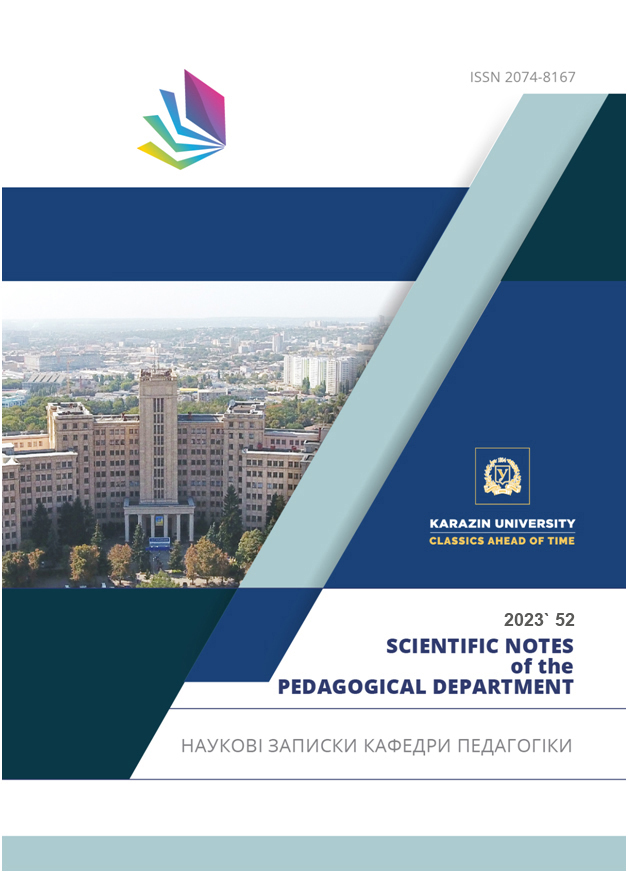Conditions of eefective social interaction of students of younger classes during distance learning
Abstract
The development of social interaction skills is important in elementary school age, because the ability to cooperate, communicate, control and express one`s feelings, make compromises, oveercome difficulties, etc. is a guarantee for the further realization of the individual in life. Unfortunately, in modern realities, in connection with the martial law, younger-schoolchildren in most regions of Ukraine do not have the opportunity to be in daily "live" communication with peers and teachers, where social interaction skills are actively developed. The distance learning format with online lessons raises a number of pedagogical and psychological problems associated with a decrease in the effectiveness of interaction between teachers and students, students among themselves, which negatively affects the development of social interaction skills. In this context, new challenges arise for teachers (as well as far parents).
Downloads
References
Honcharenko, O.S. (2016). Development of social responsibility of junior high school students in distance learning conditions. Bulletin of Kharkiv National Pedagogical University named after H. S. Skovoroda, Vol. 49, 39-45. [in Ukrainian].
Honcharenko, O.S. (2019). Socio-psychological aspects of the development of social responsibility of junior high school students in the conditions of distance learning. Scientific notes of the Department of Pedagogy, Vol. 44, 17-23. [in Ukrainian].
Honcharenko, O.S. (2017). Formation of social responsibility of younger schoolchildren through projects of the
educational process. Pedagogy and psychology, 20-28. [in Ukrainian].
Goncharenko, O.S. (2014). Psychological-pedagogical foundations of the formation of social responsibility of students of junior grades in the conditions of the development of the information society. Pedagogy and psychology, 35-42. [in Ukrainian].
Kononenko, A.O. (2010). Pedagogy of creativity: educational and methodological manual. Kyiv: Academy. 192 p. [in Ukrainian].
Kononenko, A.O. (2005). Development of students’ creative abilities: theory and practice. Kyiv: Lybid. 320 p. [in Ukrainian].
Kononenko, A.O. (2016). Formation of students’ motivation to study: theory and practice. Kyiv: Slovo Publishing House. 368 p. [in Ukrainian].
Lysenko, M. I., & Lykhovyd, O. V. (2020). The effectiveness of using interactive technologies in mathematics lessons during distance learning. Information technologies and teaching aids. Vol. 77(4), 86-101. [in Ukrainian]. 9. Pityuk, A. (2021). Social interaction in online learning: reality and possibilities Scientific notes of the Ukrainian Academy of Sciences. Pedagogical sciences. No. 233. P. 92-98. [in Ukrainian].
Anderson, T. (2013). Social Interaction in Self-Paced Distance Education. The International Review of Research in Open and Distributed Learning, Vol. 14(4), 1-13. doi: 10.19173/irrodl.v14i4.1536.
Barbour, M. K., & Reeves, T. C. (2015). Online Learning and Teaching in K-12 Settings: A Review of Open Access Literature. The International Review of Research in Open and Distributed Learning. 16(1), 133-156. DOI: 10.19173/irrodl.v16i1.1925.
Cawthon, S., & Garberoglio, C. L. (2013). The Importance of Interaction for Academic Success in Online Courses with Hearing, Deaf, and Hard-of-Hearing Students. American Annals of the Deaf. 158(4), 357-368. DOI: 10.1353/ aad.2013.0042.
Juwah, C., MacCallum, K., & Lai, M. (2011). Facilitating Social Presence in Online Learning: Interaction Affordances and Cognitive Antecedents. Australasian Journal of Educational Technolog. 27(1), 1-15. DOI: 10.14742/ajet.939 14. Lesht, F., & Warschauer, M. (2012). Creating Effective Collaborative Learning Groups in an Online Environment. International Journal of Educational Technology in Higher Education. 9(1), 26-39. DOI: 10.7238/rusc.v9i1.1172. 15. Mannen, R. A., & Robinson, S. L. (2018). Social Interaction and the Role of Technology in Distance Learning. Journal of Online Learning Research. 4(1), 1-22. DOI: 10.1016/j.jalr.2018.01.001.
Matteson, M.L., Anderson, L., Boyden, C. (2016). Soft Skills: A Phase in Search of Meaning. Portal: Libraries and the Academy. Vol. 16. No. 1. P. 71-88.
Price, D. (2015). Soft skills are critical for success but what are they? Cambridge University Press. October 22. https://www.cambridge.org/elt/blog/2015/10/22/5-easy-ways-to-integrate-soft-skills-in-your-class . 18. Raciti, P. (2015). The measurement of transversal competences in Colombia: a methodological proposal. URL: http://sia.eurosocial-ii.eu/βiles/docs/1444897404-DT34.pdf.
Richardson, J. C., & Swan, K. (2014). Social Interactions in Online Education: A Review and Synthesis. In A. A. Juan & M. Daradoumis (Eds.), Assessing the Role of Mobile Technologies and Distance Learning in Higher Education (pp. 75-102). IGI Global. DOI: 10.4018/978-1-4666-6066-9.ch005.
Rourke, L. M., & Anderson, T. (2004). Synchronous and asynchronous communication in distance learning:
A review of the literature. Quarterly review of distance education, 5(1), 1-16.
Shek, D. T., Leung, J. T., Merrick, J. (2017). Paradigm shift in youth development: Development of “soft skills” in adolescents. International Journal on Disability and Human Development, 16(4), 337-338. doi:10.1515/ ijdhd-2017-7001.
Simon, N. A., & Starling, D. D. (2019). Best practices in online teaching strategies for K-12 teachers. International Journal of Information and Learning Technology, 36(1), 2-13, DOI: 10.1108/IJILT-09-2018-0095.
The Future of Jobs Employment, Skills and Workforce Strategy for the Fourth Industrial Revolution. World Economic Forum. URL: http://reports.weforum.org/future-of-jobs-2016/.
The Future of Jobs. Report 2020. URL: http://www3.weforum.org/docs/WEF_Future_of_Jobs_2020.pdf.

